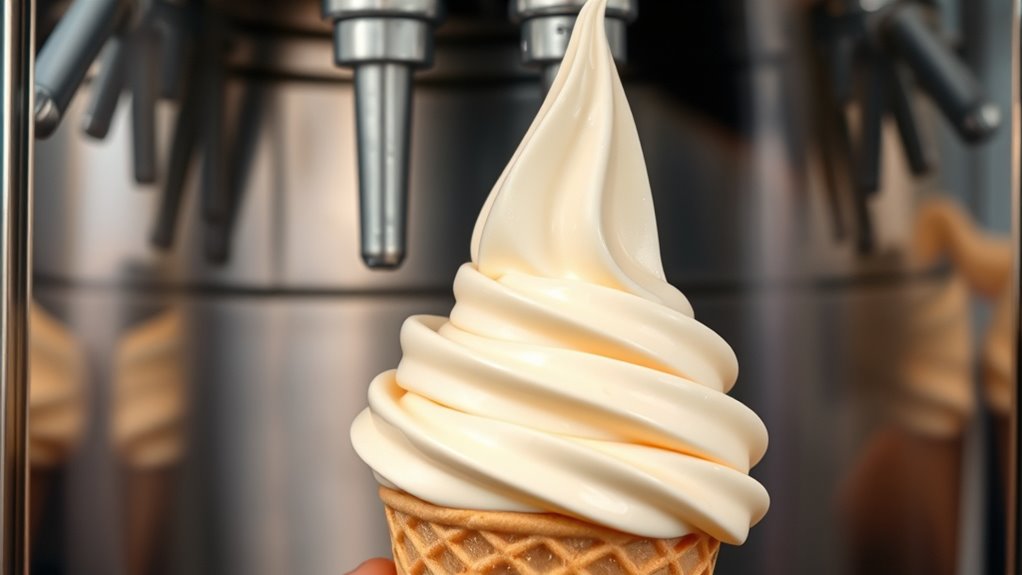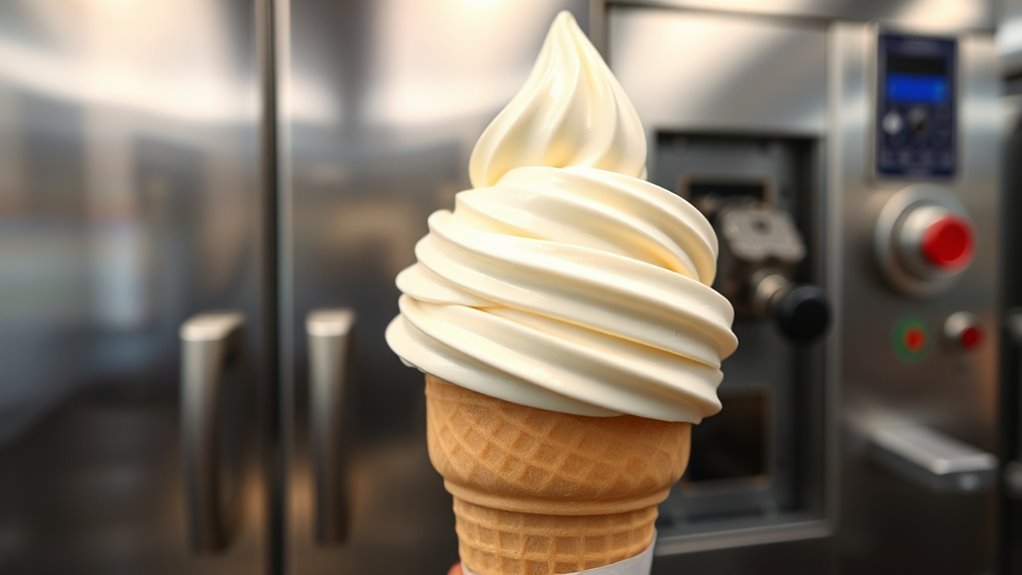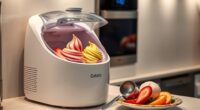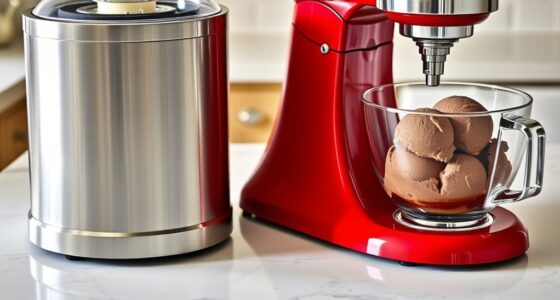The truth about soft serve and batch freezers is that their freezing technology plays a vital role in determining the texture and quality of your ice cream. When you understand how rapid freezing, overrun, and equipment calibration work, you can produce consistently smooth, creamy treats without icy or grainy textures. Proper maintenance and adjusting freezing parameters help optimize results. Keep exploring to discover how mastering these details can elevate your ice cream’s quality even further.
Key Takeaways
- Soft serve machines produce a creamy texture through continuous freezing and controlled air incorporation (overrun).
- Batch freezers allow precise control over ingredients, flavors, and mix-ins, influencing final product quality.
- Proper equipment calibration and maintenance are essential for consistent texture and preventing ice crystallization issues.
- Advanced freezing technology, like rapid freezing, creates smaller ice crystals for a smoother, velvety mouthfeel.
- Adjusting freezing parameters such as temperature and speed optimizes product consistency and overall quality.

Soft serve and batch freezers are essential equipment in the ice cream and frozen dessert industry, enabling you to produce smooth, creamy treats efficiently. The quality of your ice cream largely depends on how well you understand and utilize these machines. At the heart of their performance is the ability to deliver the perfect ice cream texture, which is achieved through advanced freezing technology. This technology is designed to incorporate just the right amount of air while rapidly freezing the mixture, resulting in a product that’s light, fluffy, and consistently smooth.
Soft serve and batch freezers produce smooth, creamy treats by utilizing advanced freezing technology for optimal texture and consistency.
When you operate a soft serve or batch freezer, you’re leveraging precise freezing technology that controls the rate at which the mixture cools and freezes. Rapid freezing prevents the formation of large ice crystals, which can make ice cream gritty or icy. Instead, the technology ensures smaller ice crystals that contribute to a velvety, creamy mouthfeel. This process also involves controlled air incorporation, known as overrun, which affects the texture and volume of your ice cream. Proper overrun means your product is not only flavorful but also has the desirable lightness that customers love.
Understanding the nuances of freezing technology helps you troubleshoot issues like ice crystallization or inconsistent texture. For example, if your ice cream feels icy or grainy, it might be a sign that the freezer isn’t maintaining proper temperature or that the mixture wasn’t cooled quickly enough. Regular maintenance and calibration of your equipment ensure that the freezing process remains ideal, allowing you to consistently produce high-quality frozen desserts. Knowing how to adjust the freezing cycle and manage the mix temperature can markedly improve the final product’s texture, making it more appealing to your customers. Additionally, paying attention to equipment calibration can help prevent common issues caused by improper settings.
Furthermore, the type of freezing technology used in your equipment influences the speed and quality of the freeze, which in turn impacts the final product’s texture and consistency. Different freezers are suited to different types of products, and understanding their specific features helps optimize your production. Soft serve machines typically operate continuously, producing a fresh, creamy consistency with high overrun, while batch freezers allow for more control over ingredient mix-ins and flavor variations. Both rely heavily on advanced freezing technology to achieve their unique textures. Understanding the different freezing methods and how they affect your product helps you tailor your process for optimal results. Mastering freezing parameters is crucial for maintaining product quality and ensuring customer satisfaction. The key is understanding the capabilities of your equipment and how to optimize its settings for the best results.
Frequently Asked Questions
How Long Does Soft Serve Ice Cream Typically Last Before Melting?
Soft serve ice cream typically lasts a short time before melting, depending on storage duration and temperature. If kept at the proper cold temperature, it can stay in perfect condition for about 15-20 minutes after serving. However, if the storage duration is prolonged or the temperature rises, melting time diminishes considerably. To maintain quality, serve it quickly and ensure your equipment stays at the recommended freezing temperature.
Can Batch Freezers Be Used for Non-Dairy Frozen Desserts?
They say “where there’s a will, there’s a way,” and that’s true for your non-dairy options. Batch freezers can definitely be used for non-dairy frozen desserts, provided you modify the ingredients accordingly. If you’re exploring alternative freezing methods, a batch freezer offers versatility and quality. Just make certain you tailor your recipes to prevent issues like ice crystal formation, making your non-dairy treats just as delightful.
What Maintenance Is Required for Soft Serve Machines?
You need to follow proper sanitization procedures regularly to keep your soft serve machine clean and prevent bacterial growth. Make sure to thoroughly clean all parts after each use and sanitize according to the manufacturer’s instructions. Additionally, adhere to a lubrication schedule for moving parts to ensure smooth operation and prevent wear. Regular maintenance extends your machine’s lifespan and guarantees high-quality, safe soft serve every time.
Are There Eco-Friendly Options for Batch Freezer Refrigerants?
You might worry eco-friendly refrigerants won’t perform well, but many sustainable cooling options are just as efficient. Today, batch freezers can use eco-friendly refrigerants like hydrofluoroolefins (HFOs) and natural gases, reducing environmental impact. These eco-friendly refrigerants provide reliable cooling without sacrificing performance. Switching to sustainable cooling options helps you lower your carbon footprint while maintaining top-quality ice cream production, making your operation both eco-conscious and efficient.
How Loud Are Commercial Soft Serve and Batch Freezers During Operation?
You’ll notice that commercial soft serve and batch freezers produce moderate noise levels during operation, which can vary depending on the model. Many units feature sound insulation to reduce noise, making them quieter in your workspace. If noise is a concern, look for machines with built-in soundproofing or consider installing additional sound insulation. This helps create a more comfortable environment while maintaining efficient operation.
Conclusion
Now that you know the ins and outs of soft serve and batch freezers, you’re better equipped to choose the right machine for your needs. Remember, even in this fast-paced digital age, a trusty batch freezer can still deliver that nostalgic charm of homemade ice cream. It’s like having your own little ice cream parlor, just without the need for a DeLorean. So go ahead, churn out those delicious treats—your sweet success awaits!











